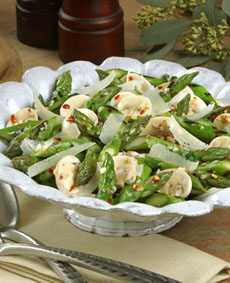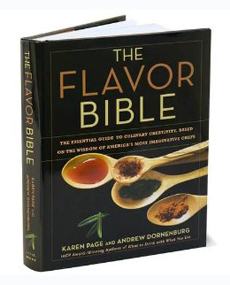TIP OF THE DAY: Guerilla Cooking With ”The Flavor Bible”
|
|
THE NIBBLE’s chef Johnny Gnall is very enthusiastic about a cooking book published in 2008. He refers regularly to The Flavor Bible: The Essential Guide to Culinary Creativity, Based on the Wisdom of America’s Most Imaginative Chefs, by Karen Page and Andrew Dornenburg. His review follows. If you have questions or suggestions for tips, email Chef Johnny.
Whenever my profession comes up in conversation, there is one question I get asked more than any other: “What is your favorite cuisine to cook at home?” The closest approximation I can offer is that I’m a champion of “guerilla cooking.” By this, I mean that I open the refrigerator and figure out my menu on the spot. Scanning the fridge for proteins and produce, thumbing through spices and jars in the pantry, I put together a meal that rarely fits neatly inside the label of any one cuisine. |
|
|
I suppose I love this kind of cooking so much because of my mom, the earliest and most ubiquitous influence on my identity as a cook. She was a working mother who often found herself at the end of the week with odds and ends in the fridge, limited time on her hands and five people to feed. Each and every time, she made the kind of dinners that had the neighborhood kids lining up for their turn to eat over. So it only makes sense that when I cook, I feel perfectly comfortable going in blind. One of the keys to success in such circumstances is knowing which products and flavors complement one another. The most effective way to gain such knowledge is experience. However, for those with less experience, The Flavor Bible is an invaluable book to help fill in the blanks. I bought my copy during culinary school on a classmate’s emphatic recommendation, and I will probably use it for the rest of my life. The Flavor Bible starts off with 30-plus pages on the nitty-gritty details of what exactly constitutes “flavor.” It begins by defining it in the equation, TASTE + MOUTHFEEL + AROMA + X-FACTOR = FLAVOR. The “X-factor” is anything perceived by our senses of sight, smell and taste, as well as emotional or mental reactions to the food. Each component of the equation is discussed in depth, even addressed philosophically at times; and is explored in as many contexts and from as many perspectives as you’re likely to come across. |
||
|
But all of this—the pontifications on flavor and the scientific breakdown of taste and aroma—is merely the introduction. The most valuable content of the cook lies in its other 350 or so pages: the flavor matchmaking charts.
These charts contain a virtually all-inclusive list of ingredients, from meat to dairy to seafood to produce, from herbs and spices to oils and vinegars—even liquors and wines. Listed below each ingredient are any and all complementary ingredients, flavors, seasonings, and cooking methods. Even with a blinding headache, you can figure out exactly what goes best with whatever you happen to have on hand. You’ll also find recipes from notable chefs peppered throughout the charts, and simple dishes and meal ideas in the margins. Warm Frisée and Bacon Salad with Beet Carpaccio and Toasted Walnuts? Yes, please! |
 Look in the fridge for ingredients: The Flavor Bible tells you what pairs best with what. Photo courtesy California Asparagus Commission. |
|
|
For those who want to start off in a general direction but keep things fast and loose, world cuisines are listed with their traditional and most popular ingredients and flavors for easy reference. Throwing a party for a Cuban friend whose family is in town? With The Flavor Bible, you know to fill your house with allspice, avocado, beans, beef, bell peppers, chicken, chocolate, citrus, cumin, garlic, lime, oregano, pineapple, plantains… you get the idea. So pick up a copy of The Flavor Bible. Then stride fearlessly to the refrigerator and swing the door open with confidence. No matter what you find starting back at you, rest assured you have the knowledge (and then some) to transform it into something delicious. And that’s a bible to swear on! |
||



